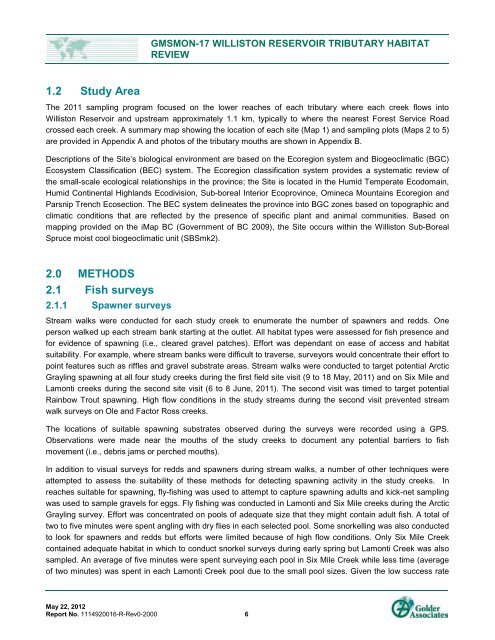GMSMON-17 WILLISTON RESERVOIR TRIBUTARY - BC Hydro
GMSMON-17 WILLISTON RESERVOIR TRIBUTARY - BC Hydro
GMSMON-17 WILLISTON RESERVOIR TRIBUTARY - BC Hydro
Create successful ePaper yourself
Turn your PDF publications into a flip-book with our unique Google optimized e-Paper software.
1.2 Study Area<br />
May 22, 2012<br />
Report No. 1114920016-R-Rev0-2000 6<br />
<strong>GMSMON</strong>-<strong>17</strong> <strong>WILLISTON</strong> <strong>RESERVOIR</strong> <strong>TRIBUTARY</strong> HABITAT<br />
REVIEW<br />
The 2011 sampling program focused on the lower reaches of each tributary where each creek flows into<br />
Williston Reservoir and upstream approximately 1.1 km, typically to where the nearest Forest Service Road<br />
crossed each creek. A summary map showing the location of each site (Map 1) and sampling plots (Maps 2 to 5)<br />
are provided in Appendix A and photos of the tributary mouths are shown in Appendix B.<br />
Descriptions of the Site’s biological environment are based on the Ecoregion system and Biogeoclimatic (BGC)<br />
Ecosystem Classification (BEC) system. The Ecoregion classification system provides a systematic review of<br />
the small-scale ecological relationships in the province; the Site is located in the Humid Temperate Ecodomain,<br />
Humid Continental Highlands Ecodivision, Sub-boreal Interior Ecoprovince, Omineca Mountains Ecoregion and<br />
Parsnip Trench Ecosection. The BEC system delineates the province into BGC zones based on topographic and<br />
climatic conditions that are reflected by the presence of specific plant and animal communities. Based on<br />
mapping provided on the iMap <strong>BC</strong> (Government of <strong>BC</strong> 2009), the Site occurs within the Williston Sub-Boreal<br />
Spruce moist cool biogeoclimatic unit (SBSmk2).<br />
2.0 METHODS<br />
2.1 Fish surveys<br />
2.1.1 Spawner surveys<br />
Stream walks were conducted for each study creek to enumerate the number of spawners and redds. One<br />
person walked up each stream bank starting at the outlet. All habitat types were assessed for fish presence and<br />
for evidence of spawning (i.e., cleared gravel patches). Effort was dependant on ease of access and habitat<br />
suitability. For example, where stream banks were difficult to traverse, surveyors would concentrate their effort to<br />
point features such as riffles and gravel substrate areas. Stream walks were conducted to target potential Arctic<br />
Grayling spawning at all four study creeks during the first field site visit (9 to 18 May, 2011) and on Six Mile and<br />
Lamonti creeks during the second site visit (6 to 8 June, 2011). The second visit was timed to target potential<br />
Rainbow Trout spawning. High flow conditions in the study streams during the second visit prevented stream<br />
walk surveys on Ole and Factor Ross creeks.<br />
The locations of suitable spawning substrates observed during the surveys were recorded using a GPS.<br />
Observations were made near the mouths of the study creeks to document any potential barriers to fish<br />
movement (i.e., debris jams or perched mouths).<br />
In addition to visual surveys for redds and spawners during stream walks, a number of other techniques were<br />
attempted to assess the suitability of these methods for detecting spawning activity in the study creeks. In<br />
reaches suitable for spawning, fly-fishing was used to attempt to capture spawning adults and kick-net sampling<br />
was used to sample gravels for eggs. Fly fishing was conducted in Lamonti and Six Mile creeks during the Arctic<br />
Grayling survey. Effort was concentrated on pools of adequate size that they might contain adult fish. A total of<br />
two to five minutes were spent angling with dry flies in each selected pool. Some snorkelling was also conducted<br />
to look for spawners and redds but efforts were limited because of high flow conditions. Only Six Mile Creek<br />
contained adequate habitat in which to conduct snorkel surveys during early spring but Lamonti Creek was also<br />
sampled. An average of five minutes were spent surveying each pool in Six Mile Creek while less time (average<br />
of two minutes) was spent in each Lamonti Creek pool due to the small pool sizes. Given the low success rate
















